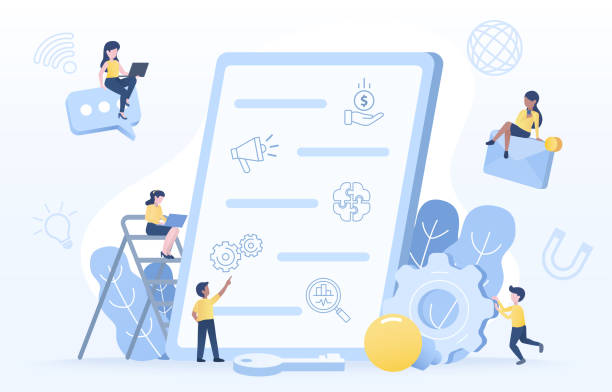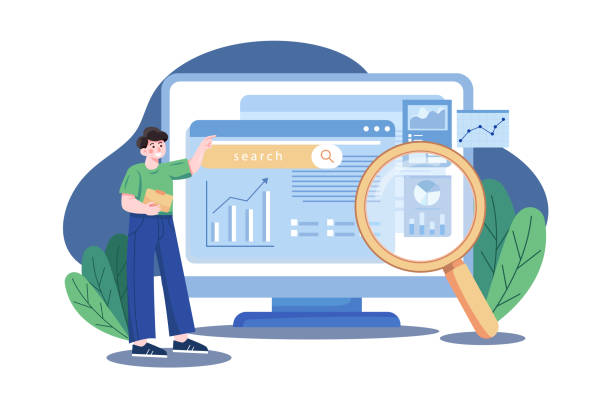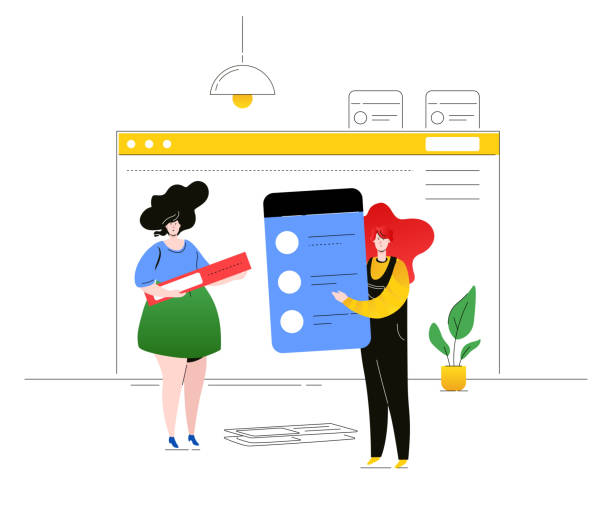An Introduction to the Importance of Multilingual Website Design

In today’s world, where geographical boundaries have faded thanks to the internet, a powerful online presence is vital for any business.
But a true presence on the web is only achieved through multilingual website design.
If you want to convey your message, products, or services to a wide range of audiences worldwide, ignoring different languages is a big mistake.
Research shows that most users prefer to interact with content in their native language; even if they are proficient in other languages.
This preference provides unique opportunities for businesses to conquer new markets and increase their share of the global market.
As a #strategic step, a multilingual website not only helps you reach a wider audience but also presents an image of an international and professional brand.
This #educational approach reminds us how a website decision can directly impact #business_growth and #international_presence.
In an era where competition in global markets has reached its peak, investing in such a capability is no longer an option but a necessity.
From increased sales to improved customer communication and enhanced brand credibility, its benefits are countless and cannot be easily overlooked.
This is an investment that will yield significant returns in the long run.
Does your current corporate website not reflect your brand’s credibility and power as it should? Rasaweb solves this challenge for you with professional corporate website design.
✅ Increased credibility and visitor trust
✅ Targeted attraction of more customers
⚡ Click to receive free consultation!
Principles and Challenges of Multilingual Website Design

Multilingual website design goes beyond mere content translation and requires adherence to specific technical and strategic principles.
One of the first challenges is the appropriate URL structure for different language versions; should subdomains (e.g., en.yoursite.com), subfolders (e.g., yoursite.com/en/), or top-level domains (e.g., yoursite.co.uk) be used? Each has its own advantages and disadvantages in terms of SEO and management.
Another challenge is content management.
How can one ensure that all content, from page texts to meta descriptions and keywords, is correctly translated and updated? This process requires an efficient Content Management System (CMS) and support for multilingual capabilities.
Technically, hreflang tags must be used correctly so that search engines can identify different language versions of a page and display them to the appropriate users.
This specialized section requires precise and up-to-date technical knowledge.
Furthermore, challenges related to user experience (UX) must also be addressed; including how to switch languages, right-to-left or left-to-right text direction, and displaying date and time in various formats.
If these issues are not managed correctly, they can disrupt user experience and lead to a decrease in conversion rates.
Therefore, before starting any multilingual website design project, meticulous planning and a deep understanding of these principles and challenges are essential.
Choosing the Best Content Management System (CMS) for Multilingual Websites

Choosing the right Content Management System (CMS) is one of the key decisions in the success of multilingual website design.
Each CMS offers different features and capabilities for managing multilingual content.
WordPress, with plugins like WPML or Polylang, is the most popular option, easily enabling the creation of different language versions.
These plugins allow for the translation of posts, pages, categories, tags, and even menus, letting you manage content for each language separately.
On the other hand, Drupal inherently offers stronger multilingual capabilities and is a suitable option for large and complex projects with high customization needs.
Joomla is another popular CMS that has good built-in features for building multilingual websites and is effective for medium to large sites.
In addition to these common options, e-commerce platforms like Shopify and Magento also offer plugins or built-in features to support different languages.
The important point in choosing a CMS is not to merely settle for page translation capabilities; rather, also pay attention to support for multilingual URLs, hreflang tags, the ability to manage translatable strings (such as error messages or buttons), and the ease of content updates in the future.
This is an educational guide to help you make the right decision.
This decision should be made based on the specific project needs, budget, and the skills of your team.
Investing in the correct CMS will make the process of multilingual website design and management much smoother.
| CMS | Multilingual Support | Ease of Use | Scalability |
|---|---|---|---|
| WordPress | With plugins (WPML, Polylang) | High | Medium to High |
| Drupal | Native, very strong | Medium | Very High |
| Joomla | Good built-in features | Medium | High |
Multilingual SEO Strategy and its Role in Increasing Traffic

SEO on a multilingual website has its own complexities, ignoring which can lead to losing a large portion of market potential.
The main goal is to ensure that search engines display the correct language versions to the appropriate users in the right locations.
For this purpose, the correct use of hreflang tags is vital.
These tags inform Google and other search engines that a page has alternative versions in different languages and which countries or languages they are targeted for.
Furthermore, Keyword Research must be performed separately for each language and region.
Keywords that are effective in one language or culture may be meaningless or inappropriate in another.
Using local keyword research tools and understanding subtle linguistic and cultural differences is essential for identifying relevant search phrases.
The multilingual SEO strategy also includes Geo-targeting, which can be configured via Google Search Console and helps search engines understand the target country for your content.
Technical optimization, a logical URL structure, and high-quality, localized content are all essential pillars of this analytical and specialized process.
Finally, Link Building in each language should also be carried out separately, considering the credibility of websites in that region.
Success in multilingual website design is tied to a strong SEO approach.
Are you worried that your company’s old website might scare away new customers? Rasaweb solves this problem forever with modern and efficient corporate website design.
✅ Increases your brand’s credibility.
✅ Helps attract targeted customers.
⚡ Contact Rasaweb for a free consultation!
User Experience (UX) on Multilingual Websites

User Experience (UX) holds special importance in multilingual website design and goes beyond mere content translation.
An excellent UX allows users to easily interact with the site in their preferred language.
One of the key aspects is simplifying the language switching process.
The language switch button or menu should be clearly visible and in a consistent location (usually in the header or footer).
Also, language names should be displayed in their native language (e.g., ‘English’ instead of ‘انگلیسی’ or ‘Français’ instead of ‘فرانسه’) so that the user can easily find their desired language.
Furthermore, cultural considerations play a very important role.
Colors, images, icons, and even page layout may have different meanings in various cultures.
Website content should be localized, not just translated.
Localization means adapting content to the norms, values, and cultural expectations of the target audience.
This includes currency, date and time formats, addresses, and even humor and colloquialisms.
Adhering to text direction (right-to-left for languages like Persian and Arabic, and left-to-right for most European languages) is also a fundamental principle.
Precise guidance on UX can help retain users and increase conversion rates.
Ignoring these details can lead to user confusion and an unpleasant experience, ultimately harming brand credibility.
The goal of multilingual website design is to provide a seamless and comfortable experience for all users, regardless of their language.
Content and Translation Management on Multilingual Websites

Content management and the translation process are among the most important aspects of multilingual website design.
Simply relying on machine translation tools like Google Translate is not enough and can even damage your brand’s reputation.
To ensure content quality and accuracy, you should use native and specialized translators in your field.
These translators are not only fluent in the language but also familiar with cultural nuances and common idioms, which leads to the production of localized and natural content.
Establishing an efficient Translation Management Workflow is essential.
This process includes the following steps: content extraction, translation, review by a second translator, and then re-uploading the translated content into the CMS.
Using CAT (Computer-Assisted Translation) tools and Translation Memories can help maintain consistency in terminology and reduce translation costs in the long run.
Also, planning for future content updates is very important.
Whenever the original content changes, the translated versions must also be updated quickly to avoid providing contradictory information.
This is an educational and explanatory aspect that is often overlooked.
It must be ensured that all elements of the site, including button texts, error messages, images, and multimedia files, are also correctly translated and localized.
Visual content should also be considered, as some images or symbols may have different meanings or even be considered offensive in various cultures.
The success of a multilingual website directly depends on the quality of translation and continuous content management.
Commercial and Marketing Benefits of Multilingual Website Design

Multilingual website design is more than a technical feature; it’s a powerful marketing and business strategy that can significantly impact your business growth.
The first and most obvious benefit is expanding access to global markets.
By providing content in different languages, you gain access to millions of new users who were previously outside your business’s reach due to language barriers.
This directly leads to increased sales and revenue, as customers are more inclined to buy from websites that speak their native language.
Furthermore, a multilingual website helps improve your international SEO.
By correctly using hreflang tags and localized content, your site will rank better in local search results in different countries, which means increased organic and targeted traffic.
This itself is a newsworthy and exciting opportunity for companies looking for rapid growth.
Increased credibility and trust are also significant benefits.
A site available in multiple languages projects an image of a reputable, customer-centric, and global brand.
This not only gains customer trust but can also help establish new business relationships and expand partner networks.
Finally, multilingual website design gives you a significant competitive advantage, as many competitors are still unaware of this great potential.
This is a precise analysis of the tangible benefits of this approach.
| Benefit | Explanation |
|---|---|
| Market Expansion | Access to new customers worldwide |
| Improved Global SEO | Better ranking in local search results |
| Increased Sales and Revenue | Higher conversion rate from native audiences |
| Increased Brand Credibility | Creating an image of an international and reputable brand |
| Competitive Advantage | Superiority over competitors who are only active in one language |
Common Mistakes in Multilingual Website Design and Ways to Avoid Them

On the path to multilingual website design, there are common mistakes that can render your efforts and investments ineffective.
One of the biggest mistakes is sole reliance on machine translation.
While tools like Google Translate can be useful for general understanding, they are not sufficient for professional and localized content.
Machine translation often lacks accuracy, cultural nuances, and appropriate tone, which can result in awkward or even offensive texts.
The solution is to use professional and native translators.
Another mistake is ignoring multilingual SEO.
Many sites merely translate content but neglect hreflang tags or fail to perform keyword research for each language.
This prevents search engines from correctly indexing different language versions of the site and displaying them to target users.
The main guidance is to definitely develop a comprehensive SEO strategy for each language.
Lack of attention to region-specific user experience (UX) is also a common mistake.
Issues such as text direction (RTL/LTR), date and time formats, currency, and even appropriate fonts for each language must be considered.
A multilingual site should convey a sense of being native in each language.
Failure to continuously update translated content is another problem that can lead to outdated and inconsistent information.
These issues create questionable content.
Planning for regular maintenance and updates of all language versions of the site is essential to maintain quality and accuracy.
Avoiding these mistakes requires meticulous planning, expertise, and a commitment to quality throughout all stages of multilingual website design.
Are you tired of your company’s website not being seen as it deserves, losing potential customers? Solve this problem forever with professional and effective website design by Rasaweb!
✅ Increase brand credibility and gain customer trust
✅ Attract targeted sales leads
⚡ Contact us now for a free consultation!
The Future of Multilingual Website Design and Emerging Trends

The future of multilingual website design is constantly evolving, with many emerging trends taking shape that have the potential to change how we interact with global content.
One of the most important of these trends is the astonishing advancements in Artificial Intelligence (AI) and machine learning in the field of translation.
While pure machine translation is not yet ideal for sensitive and critical content, AI-powered tools with continuous learning and improvement capabilities are approaching human translation quality.
These technologies can accelerate the translation process and reduce costs, allowing businesses to offer their content in new languages more quickly.
Another trend is content personalization.
In the future, multilingual websites will not only change content based on the user’s language but will also display more personalized and relevant content based on geographical location, browsing history, and individual preferences, using user data.
This can significantly improve user experience and increase conversion rates.
Voice Search and the emergence of voice assistants will also impact multilingual strategy; websites must be optimized to respond to voice queries in different languages.
This is a fun yet analytical opportunity to predict the future.
Finally, focusing on native user experience, multilingual cybersecurity, and using emerging technologies like blockchain to verify translation authenticity are other aspects that will shape the future of multilingual website design.
Conclusion and Next Steps for Launching a Successful Multilingual Website

As explored in this explanatory and comprehensive article, multilingual website design is a strategic and vital investment for any business seeking to expand its presence in global markets.
This process goes beyond mere text translation and requires meticulous planning, selecting the right CMS, a strong SEO strategy, attention to native user experience, and high-quality content management.
Its benefits, including increased audience reach, improved international SEO, increased sales, and enhanced brand credibility, fully justify these efforts.
To launch a successful multilingual website, consider the following steps:
- Comprehensive Planning: Define your goals, select target languages, and carefully study the relevant markets and cultures.
- Choosing the Right CMS: Choose a platform that offers the best multilingual support and is compatible with your technical and operational needs.
- Native Keyword Research: Perform keyword research separately for each language and region to optimize your content for local searches.
- Professional Translation and Localization: Use native and specialized translators and pay attention to cultural details, tone, and idioms.
Don’t forget visual content either. - Multilingual Technical SEO: Correctly use
hreflangtags and have a logical URL structure for each language. - Native UX Design: Ensure easy language switching and synchronize layout, fonts, and images with the culture of each region.
- Continuous Maintenance and Updates: Have a regular plan for updating translated content and monitoring SEO and UX performance in each language.
By following these guidelines, you can create a multilingual website design that is not only technically powerful but also effectively communicates with audiences in international markets.
This is an investment in the future of your business.
Frequently Asked Questions
| Question | Answer |
|---|---|
| What is a multilingual website? | It is a website whose content is available to users in several different languages. |
| Why should we design a multilingual website? | To expand access to international audiences, increase website traffic, improve SEO in target markets, and provide a better user experience for non-Persian speaking users. |
| What are the main methods for implementing a multilingual website? | Using subdomains (e.g., en.mysite.com), using subdirectories (e.g., mysite.com/en/), and using separate domains for each language (e.g., mysite.com and mysite.de). |
| Which implementation method is better for SEO? | Generally, using subdirectories (language folders) is often recommended due to the transfer of authority from the main domain to other languages. |
| What is the Hreflang tag and what is its use? | It is an HTML tag or HTTP Header that tells search engines which version of a page is suitable for which language or geographical region. This tag prevents duplicate content and improves SEO. |
| How is a Language Switcher designed? | Usually, by using a dropdown menu, button, or flag in the website’s header or footer, which allows the user to select their preferred language. |
| Is automatic (machine) translation suitable for a multilingual website? | No, machine translation usually has low quality and many errors that can harm the website’s credibility. Human translation or a combination of human translation and machine editing is recommended. |
| What are the most important SEO tips in multilingual website design? | Correct use of the Hreflang tag, having an appropriate URL structure for each language, translating titles and meta descriptions, translating core content, internal linking between related language versions. |
| Should all website content be translated? | It depends on the strategy. Usually, the main and important content of the site should be translated. Less important sections or blogs may not require full translation. |
| What are the main challenges in multilingual website design? | Content management in different languages, translation costs, technical issues related to URLs and language tags, template compatibility with right-to-left (RTL) languages such as Persian and Arabic, and multilingual SEO management. |
And other services of Rasaweb Advertising Agency in the field of advertising
Smart Reportage: A dedicated service for growth in SEO ranking improvement based on user experience customization.
Smart Conversion Rate Optimization: A dedicated service for growth in campaign management based on user experience customization.
Smart Data Analysis: A fast and efficient solution for increasing click-through rates with a focus on custom programming.
Smart Direct Marketing: A combination of creativity and technology to increase click-through rates through attractive UI design.
Smart Sales Automation: A dedicated service for growth in SEO ranking improvement based on precise audience targeting.
And over hundreds of other services in the field of internet advertising, advertising consultation, and organizational solutions
Internet Advertising | Advertising Strategy | Advertorial
Sources
Benefits of a Multilingual Website
Multilingual Website SEO Guide
How to Design a Multilingual Website?
Importance of Multilingual Website Design
📍 Ready to transform your business in the digital world? Rasaweb Afarin Digital Marketing Agency, specializing in responsive website design, SEO optimization, and professional social media management, assists you on the path to growth and achieving big goals.
📍 Tehran, Mirdamad Street, next to Central Bank, Southern Kazeroun Alley, Ramin Alley, No. 6

